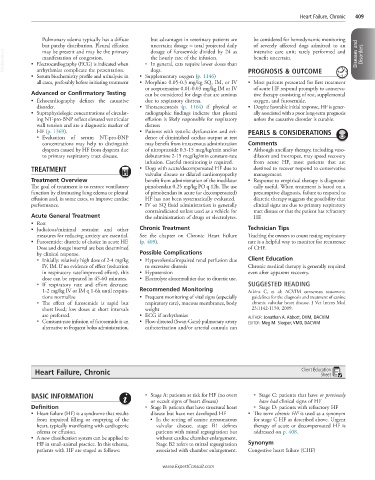Page 851 - Cote clinical veterinary advisor dogs and cats 4th
P. 851
Heart Failure, Chronic 409
Pulmonary edema typically has a diffuse but advantages in veterinary patients are be considered for hemodynamic monitoring
but patchy distribution. Pleural effusion uncertain; dosage = total projected daily of severely affected dogs admitted to an
VetBooks.ir • Electrocardiography (ECG) is indicated when ○ In general, cats require lower doses than benefit uncertain. Diseases and Disorders
intensive care unit; rarely performed and
dosage of furosemide divided by 24 as
may be present and may be the primary
the hourly rate of the infusion.
manifestation of congestion.
dogs.
arrhythmias complicate the presentation.
• Serum biochemistry profile and urinalysis: in • Supplementary oxygen (p. 1146) PROGNOSIS & OUTCOME
all cases, preferably before initiating treatment • Morphine 0.05-0.3 mg/kg SQ, IM, or IV • Most patients presented for first treatment
or acepromazine 0.01-0.03 mg/kg IM or IV of acute HF respond promptly to conserva-
Advanced or Confirmatory Testing can be considered for dogs that are anxious tive therapy consisting of rest, supplemental
• Echocardiography defines the causative due to respiratory distress. oxygen, and furosemide.
disorder. • Thoracocentesis (p. 1164) if physical or • Despite favorable initial response, HF is gener-
• Supraphysiologic concentrations of circulat- radiographic findings indicate that pleural ally associated with a poor long-term prognosis
ing NT-pro-BNP reflect elevated ventricular effusion is likely responsible for respiratory unless the causative disorder is curable.
wall tension and are a diagnostic marker of distress
HF (p. 1369). • Patients with systolic dysfunction and evi- PEARLS & CONSIDERATIONS
○ Evaluation of serum NT-pro-BNP dence of diminished cardiac output at rest
concentrations may help to distinguish may benefit from intravenous administration Comments
dyspnea caused by HF from dyspnea due of nitroprusside 0.5-15 mcg/kg/min and/or • Although ancillary therapy, including vaso-
to primary respiratory tract disease. dobutamine 2-15 mcg/kg/min constant-rate dilators and inotropes, may speed recovery
infusion. Careful monitoring is required. from acute HF, most patients that are
TREATMENT • Dogs with acute/decompensated HF due to destined to recover respond to conservative
valvular disease or dilated cardiomyopathy management.
Treatment Overview benefit from administration of the inodilator • Response to empirical therapy is diagnosti-
The goal of treatment is to restore ventilatory pimobendan 0.25 mg/kg PO q 12h. The use cally useful. When treatment is based on a
function by eliminating lung edema or pleural of pimobendan in acute (or decompensated) presumptive diagnosis, failure to respond to
effusion and, in some cases, to improve cardiac HF has not been systematically evaluated. diuretic therapy suggests the possibility that
performance. • IV or SQ fluid administration is generally clinical signs are due to primary respiratory
contraindicated unless used as a vehicle for tract disease or that the patient has refractory
Acute General Treatment the administration of drugs or electrolytes. HF.
• Rest
• Judicious/minimal restraint and other Chronic Treatment Technician Tips
measures for reducing anxiety are essential. See the chapter on Chronic Heart Failure Teaching the owners to count resting respiratory
• Furosemide: diuretic of choice in acute HF. (p. 409). rate is a helpful way to monitor for recurrence
Dose and dosage interval are best determined of CHF.
by clinical response. Possible Complications
○ Initially: relatively high dose of 2-4 mg/kg • Hypovolemia/impaired renal perfusion due Client Education
IV, IM. If no evidence of effect (reduction to excessive diuresis Chronic medical therapy is generally required
in respiratory rate/improved effort), this • Hypotension even after apparent recovery.
dose can be repeated in 45-60 minutes. • Electrolyte abnormalities due to diuretic use.
○ If respiratory rate and effort decrease: SUGGESTED READING
1-2 mg/kg IV or IM q 1-6h until respira- Recommended Monitoring Atkins C, et al: ACVIM consensus statement:
tions normalize • Frequent monitoring of vital signs (especially guidelines for the diagnosis and treatment of canine
○ The effect of furosemide is rapid but respiratory rate), mucous membranes, body chronic valvular heart disease. J Vet Intern Med
short lived; low doses at short intervals weight 23:1142-1150, 2009.
are preferred. • ECG if arrhythmias AUTHOR: Jonathan A. Abbott, DVM, DACVIM
○ Constant-rate infusion of furosemide is an • Flow-directed (Swan-Ganz) pulmonary artery EDITOR: Meg M. Sleeper, VMD, DACVIM
alternative to frequent bolus administration, catheterization and/or arterial cannula can
Heart Failure, Chronic Client Education
Sheet
BASIC INFORMATION ○ Stage A: patients at risk for HF (no overt ○ Stage C: patients that have or previously
or occult signs of heart disease) have had clinical signs of HF
Definition ○ Stage B: patients that have structural heart ○ Stage D: patients with refractory HF
• Heart failure (HF) is a syndrome that results disease but have not developed HF • The term chronic HF is used as a synonym
from impaired filling or emptying of the ■ In the setting of canine myxomatous for stage C HF as described above. Urgent
heart, typically manifesting with cardiogenic valvular disease, stage B1 defines therapy of acute or decompensated HF is
edema or effusion. patients with mitral regurgitation but addressed on p. 408.
• A new classification system can be applied to without cardiac chamber enlargement.
HF in small-animal practice. In this schema, Stage B2 refers to mitral regurgitation Synonym
patients with HF are staged as follows: associated with chamber enlargement. Congestive heart failure (CHF)
www.ExpertConsult.com

